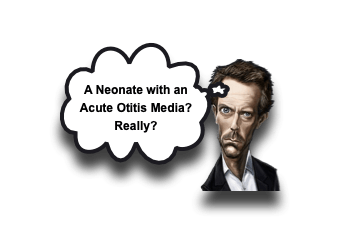Neonatal Acute Otitis Media

Neonatal Acute Otitis Media: Really?
I’ll be honest, if I am told that a neonate has an acute otitis media (AOM), my first instinct is to mistrust that claim and become offended that I’m being lied to. Why? because it is just so challenging to make the diagnosis in child less than 2 months of age. [Sommerfleck, 2013]
- External auditory canals are extremely narrow and collapsible
- View of tympanic membrane (TM) is often obstructed
- TM is more obliquely or horizontally positioned
- A little cerumen obstructs proportionally more of the small canal
- A forrest of ear hair also obstructs the small canal
- Even if the TM can be clearly seen, the determination of AOM is still challenging in the very young.
- It is known that redness of the TM alone is not reliable indicator as fever in a young child can cause the TM to change color.
- Distinguishing the presence of a middle ear effusion can be challenging in older and larger children… so it is very difficult in the neonate and young infant.
- Most studies use tympanocentesis to make the diagnosis. [Sakran, 2006; Turner, 2002]
It is feasible though, to make the diagnosis in neonates and young infants. Since the difficulties are based on anatomic barriers, if the specific infant’s anatomy affords the clinician a good view and the diagnostic criteria are present, then the diagnosis can be made. Then what?
Neonatal Acute Otitis Media: Full Sepsis Work-Up?
Since the 1980’s (yup, that was a long time ago) we have been struggling with determining which infants are low or high risk for serious bacterial infections. Whichever criteria you use, there is often a stipulation that AOM either increases the risk for systemic infection or it should not be considered as a source of the fever. This often equates to doing full sepsis work-up in neonates and children < 2 months of age with AOM.
- Children less than 2 months have a limited immune system
- Defining an infection in them would seem to increase their risk for that infection to become disseminated.
On the other hand, we have already discussed how having a Urinary Tract Infection in a young infant may not substantially increase her/his risk for meningitis, especially for the >28 day old child. Could the same be true for AOM?
- Several, relatively small, studies have looked at AOM in neonates and infants < 3 months of age. [Sommerfleck, 2013; Sakran, 2006; Turner, 2002; Nozicka, 1999]
- Bacterial Considerations:
- Neonatal sepsis is often due to E.Coli or GBS (and once in a blue moon, Listeria)
- AOM in neonates is caused by the same bacteria that cause AOM in older infants and children (ex. S. pneumoniae, H. influenzae, M. catarrhalis) and not E. Coli or GBS.
- AOM and Serious Bacterial Infections
- Previously healthy, non-toxic and afebrile infants 2-8 weeks with isolated AOM are at very low risk for concomitant bacteremia or meningitis. [Turner, 2002; Nozicka, 1999]
- The presence of AOM in febrile infants < 2 months classified as low risk (via fever risk stratification methods) was not associated with meningitis or bacteremia. [Turner, 2002]
- Patients classified as high risk did have greater risk for SBI. [Turner, 2002]
- AOM in febrile infants (< 3months) was found to have concomitant UTI and Bronchiolitis and not bacteremia or meningitis. [Sakran, 2006]
- Outpatient management is sufficient in low-risk, non-toxic appearing infants with isolated AOM in kids <2 months of age. [Sakran, 2006; Turner, 2002]
Neonatal Otitis Media: A Reasonable Approach?
So what does that leave us with? Well… here is my interpretation of what is known thus far… obviously, this does not determine what is the “Gold Standard”… honestly, it is barely a copper standard.
- Toxic Appearing?
- Simple – DO IT ALL!
- Consider covering for HSV.
- 0-28 days?
- Febrile with AOM?
- Data is unclear… [Sakran, 2006]
- Don’t over think it, even if you have an AOM present.
- Have low threshold for full fever evaluation and hospitalization for empiric antibiotics.
- Afebrile with AOM?
- This group is also unclear.
- Realize your AOM diagnosis may be incorrect, but if you are certain, I would likely have a low threshold for attempting to apply your favorite risk stratification tool.
- CLOSE follow-up will be imperative!
- Febrile with AOM?
- 1-2 months of age? [Sakran, 2006]
- Febrile with AOM?
- Lower risk for concomitant meningitis and bacteremia.
- UTI can be present.
- If low risk by stratification, can be treated as outpatients.
- Afebrile with AOM?
- Risk of concomitant serious bacterial infection is low.
- Can be treated as outpatients.
- Febrile with AOM?
Moral of the Morsel
- It may be a focal problem! AOM can be a localized infection in young infants.
- Your eyes may be deceiving you! Take care to not allow your desire to avoid a lumbar puncture influence your visual diagnosis of AOM… AOM is a difficult diagnosis to make in tiny infants.
- Outpatient is possible, if you are Confident. Infants 1-2 months of age with AOM who appear well and are at low risk for SBI can be treated as outpatients… I’m not gonna be as cavalier with the neonate (<28 days) personally.

